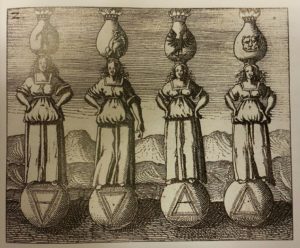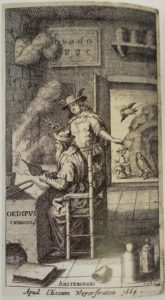Alchemy is an old and secretive practice that is neither magical nor scientific but manages to bridge these two fields. Most often is it described as the forerunner to chemistry which aimed to turn base metals into gold and to discover the secrets of immortality. It was an international pursuit with many different people from different cultures and time periods contributing to its advancement.
Alchemy had three primary objectives (Alchemy 1891):
- Creation of the Elixir of Life. This is a liquid which was said to cure all ailments, reverse old age and prolong the life of anyone who ingested it. Because of gold’s perfect nature as a metal (it couldn’t be corroded or dissolved), some alchemists thought that the Elixir of Life could be extracted from gold.
- Creation of the Alcahest. This is a universal solvent which was said to dissolve all other matter.
- Creation of the Philosopher’s Stone. This is a stone which was said to have the power to turn base metals into perfect metals. For example, turning copper into gold. The Philosopher’s Stone could do for metals what the Elixir of Life could do for mortals.
The exact origins of alchemy are unknown. This is partially because it was a secret practice so many details have been deliberately withheld, and also because there are several cultures which individually pursued what we would recognise as alchemy today (Leo 1972; Burland 1967). The earliest texts to mention alchemy are Hellenistic and Alexandrian, but further records of alchemy have been found in China and throughout the Middle East and Europe. As alchemy does not have one clear inventor, it is likely that a number of people from different cultures developed this practice. As such, a very brief overview of some noteworthy figures and their contribution will be detailed here.
Aristotle argued that wisdom is the objective of philosophy, and he defined wisdom as knowledge regarding principles and causes (Aristotle 2004). To this end, the ancient Greeks sought to understand how the world around them was created. Although ancient Greek Philosophers lacked our modern technological advances, they theorised that all the universe is made of matter and that everything is created by mixing certain quantities of various matter (Burland 1967). Today, we know this to be true and have even recorded all the known elements of the universe in the Periodic Table.

The ancient Greek Philosophers identified four basic elements from which they believed all things were made: earth, fire, wind and water. They reasoned that any material, once heated, will create moisture (water) and steam or gas (air). The gasses are likely to be flammable (fire), and all material, once totally burned, will become a heap of burnt earthy material (earth) (Burland 1967). Furthermore, Aristotle reasoned that these four elements could be further transmuted by applying heat, cold, dryness or fluidity (Burland 1967). These four basic elements are each represented by a triangular symbol in alchemy, and smelting and distillation are key methods by which Alchemists sought to transmutate metals and create the Elixir of Life.
Meanwhile, gold was revered by the ancient Egyptians as a symbol of spiritual and material perfection before the word ‘alchemy’ was coined (Leo 1972). Some people say that Alchemy began in Egypt when Thoth, the God of Knowledge, wrote its secrets down in a codified language that only wise and diligent men could decipher (Leo 1972). It would appear that from its origins, Alchemy was shrouded in mystery and only intended for a select few. Furthermore, the ancient Egyptians attitude towards gold is in line with the Alchemists’ belief that gold was the most precious metal because it could not be altered by fire, dissolved in water or corroded by air (Alchemy 1891). It is speculated that this is why gold is represented by the sun in Alchemy as the sun is the most important celestial being because all life depends on it.
While ancient Greek and Egyptian Alchemists were concerned with the properties of nature, Chinese alchemy was concerned with immortality. Chinese alchemy is said to be greatly influenced by Taoism (Leo 1972). ‘Tao’ translates as the Way of the Universe and teaches that perfection can be attained by finding a balance with nature (Holmyard 1957). Taoists wish for a long life which will give them enough time to prepare for Paradise (Holmyard 1957). The wish for long life gradually morphed into a wish for immortality and this led to the study of Alchemy in the hopes of producing the Elixir of Life (Holmyard 1957). The first Chinese Alchemist was most likely Dzou Yen who lived circa 400BC and was noted for performing a number of miracles. He is also noted for advancing the notion that all the phases of the cosmos can be explained by the cycles of the five elements: earth, wood, fire, metal and water (Editors of Encyclopædia Britannica 2017). This theory is almost identical to that of the ancient Greeks with the inclusion of the element of metal. Dzou Yen further postulated that these elements were governed by the opposing forces of Yin (earth, female, passive, absorbing) and Yang (heaven, active, male, penetrating). Again, this is similar to Aristotle’s notion that matter can be transformed by subjecting it to a catalyst. This supports the idea that different cultures separately pursued Alchemy but with converging notions and goals.
Alchemy was further advanced in the Middle East during the Islamic expansion of 500-1200AD. During this time, Islamic rulers respected scientific knowledge from all sources and many texts from around the world were translated into Arabic. As such, alchemeic texts were translated into Arabic. One of the most noteworthy Middle Eastern Alchemists was Jabir who was born in Tus in circa 721AD (Leo 1972). He rose to prominence when he cured the wife of one of the sultan’s advisers who was suffering from a mystery illness and subsequently became the Court Alchemist. He wrote many texts regarding Alchemy, Philosophy, Geometry and Engineering and was so well renowned that many treaties were named after him and many future alchemists named themselves after him. Incidentally, the Latin translation of Jabir is ‘Geber’ and some of the Latin texts on alchemy which were written under this pseudonym were so difficult to decipher that the word ‘gibberish’ was created to refer to nonsensical writing (Leo 1972).

It is likely that through Islamic expansion, alchemy made its way into Europe via Spain, just as Tarot Cards are speculated to have done (you can read more about the origins of Tarot Cards in this PAN blog post). One noteworthy European Alchemist was Nicholas Flamel, whose name may be known to you from Harry Potter and the Philosopher’s Stone. He was a French scrivener (transcriber of books) who lived in France in in the 1300s. One day, one of his clients brought him a strange book to translate. The cover was made of brass and covered with ‘strange looking letters’ which Flamel supposed might be Greek (Leo 1972). Inside, the book contained coloured illustrations, symbols and Latin text (Leo 1972). Flamel could not decipher the text, so he asked for assistance from the French Physician, Anselm who was said to know about Alchemy. With a little help from Anselm, Flamel embarked on a 24 year journey to create the Philosopher’s Stone which then allowed him to first turn mercury into silver and then gold (Leo 1972). Considering that we now know that gold, silver and mercury are all elements and therefore are not made up of any combination of elements, this claim appears highly dubious, but since when has science had anything to do with legend?
Unfortunately, Alchemists did not achieve their three objectives but they did make some important scientific discoveries such as (Alchemy 1891):
- Matter is indestructible. You can change its form, but you can never destroy it.
- Matter can be mixed and separated.
- All forms of matter have particular properties which always apply to them.
These discoveries marked the beginning of the transition from alchemy to chemistry. Who would have thought that one of the hard sciences would have its origins in fantastical pursuits?
References
‘Alchemy’ 1891, Science, vol. 18, no. 447, pp. 113-117, viewed 10 October 2017, American Association for the Advancement of Science, JSTOR
Aristotle 2004, The Metaphysics, Trans. Hugh Lawson-Tancred, Penguin Books, London
Burland, CA 1967, The Arts of the Alchemists, Weidenfeld and Nicholson Ltd, Letchworth, Hertfordshire
Editors of Encyclopædia Britannica 2017, ‘Zou Yan Chinese Philosopher’, Encyclopeadia Britannica, viewed 16 October 2017, < https://www.britannica.com/biography/Zou-Yan>
Holmyard, EJ 1957, Alchemy, Penguin Books, Mitcham, VIC
Leo, W 1972, Alchemy, Shelbourne Press Inc, Los Angeles, CA
